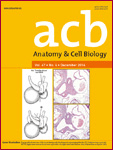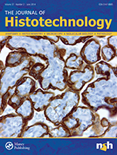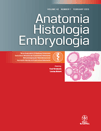
ANNALS OF ANATOMY-ANATOMISCHER ANZEIGER
Scope & Guideline
Illuminating the Path of Anatomical Discovery
Introduction
Aims and Scopes
- Morphological Studies:
The journal publishes detailed morphological studies that explore the structure and variations of anatomical entities across different species, including humans, and how these relate to function. - Clinical and Applied Anatomy:
Research that bridges anatomical knowledge with clinical practice is a core focus, addressing the implications of anatomical variations in surgical procedures and medical treatments. - Innovative Imaging Techniques:
There is a strong emphasis on the use of advanced imaging techniques such as MRI, CT, and ultrasound in anatomical studies, allowing for non-invasive assessment of anatomical structures. - Stereology and Quantitative Analyses:
The journal features studies that utilize stereological methods and quantitative analyses to evaluate the spatial arrangement and volume of anatomical structures, contributing to a deeper understanding of their functional significance. - Ethical Considerations in Anatomy:
Research highlighting ethical considerations in anatomical studies, particularly in the context of body donation and the use of human cadavers, reflects the journal's commitment to responsible scientific practices. - Educational Approaches:
The journal also includes articles on innovative teaching methods in anatomy education, particularly in light of challenges posed by the COVID-19 pandemic, emphasizing the importance of effective learning strategies.
Trending and Emerging
- Integration of Technology in Anatomy Education:
The use of digital tools and virtual reality in anatomy education is gaining traction, providing innovative ways to enhance learning and engagement among medical students. - Research on Anatomical Variability:
There is an increasing focus on anatomical variability and its clinical implications, with studies examining how individual differences can affect surgical outcomes and treatment plans. - Multidisciplinary Approaches:
Emerging themes reflect a growing interest in multidisciplinary approaches that integrate anatomy with fields such as bioengineering, regenerative medicine, and molecular biology, fostering collaboration across scientific domains. - Ethical and Legal Issues in Body Donation:
As ethical considerations around body donation become more prominent, research addressing the legal and ethical frameworks governing anatomical studies is increasingly relevant and necessary. - Innovative Regenerative Techniques:
The exploration of regenerative techniques and their anatomical implications is becoming more prevalent, particularly in studies focused on tissue engineering and stem cell research.
Declining or Waning
- Historical Anatomical Studies:
There has been a noticeable decline in studies focusing on historical anatomical practices and the legacy of historical anatomists, as contemporary research trends shift towards applied and clinical anatomy. - Basic Anatomical Descriptions:
Research that solely describes anatomical structures without substantial clinical application or innovative methodologies seems to be waning, as the field increasingly values studies with direct implications for practice. - Animal Models in Anatomy:
The use of traditional animal models for anatomical research appears to be diminishing in favor of more advanced techniques and human-centric studies, reflecting a broader trend towards translational research.
Similar Journals

HOMO-JOURNAL OF COMPARATIVE HUMAN BIOLOGY
Fostering Innovation in Comparative StudiesHOMO - Journal of Comparative Human Biology is a prestigious academic journal dedicated to advancing the field of comparative human biology, offering a platform for researchers, professionals, and students to disseminate cutting-edge findings. Published by E Schweizerbart'sche Verlagsbuchhandlung in Germany, this journal has been a crucial resource since its inception in 1950, featuring a rich archive of studies until 2023. It holds a Q3 quartile ranking in Anthropology and a Q4 quartile ranking in Miscellaneous Medicine, reflecting its significance and influence within the academic community. Although not an Open Access journal, it provides a wealth of robust research that intersects with various disciplines within the anthropological sciences. Researchers looking for a wide array of comparative studies and insights into human biology will find HOMO an invaluable addition to their scholarly resources.

ANATOMICAL SCIENCE INTERNATIONAL
Unveiling Innovations in Anatomical ScienceANATOMICAL SCIENCE INTERNATIONAL is a distinguished peer-reviewed journal published by SPRINGER, focusing on the field of anatomy and its applications within the broader spectrum of medical science. With an ISSN of 1447-6959 and an E-ISSN of 1447-073X, this journal provides a robust platform for the dissemination of innovative research and findings from around the globe, featuring studies that span from basic anatomy to advanced clinical applications. As of 2023, it holds a respectable Q2 rank in Anatomy and a Q3 rank in the miscellaneous category of Medicine, reflecting its growing influence and contribution to the field, with Scopus rankings placing it in the 59th percentile of Medicine - Anatomy journals. Although ANATOMICAL SCIENCE INTERNATIONAL is not an Open Access journal, it remains indispensable for researchers, professionals, and students who seek to stay at the forefront of anatomical science research. The journal's ongoing commitment to excellence is evident through its continuous publication, spanning from 2002 and projected through 2024, making it a vital resource for those aiming to advance their knowledge and practice in anatomy.

Anatomy & Cell Biology
Innovating Insights in Anatomy and Cellular DynamicsAnatomy & Cell Biology is a prominent academic journal published by MEDRANG, dedicated to advancing the fields of anatomy and cell biology through the dissemination of high-quality research. With an ISSN of 2093-3665 and an E-ISSN of 2093-3673, this journal serves as a vital resource for researchers and professionals interested in understanding the intricate processes of human and model organism anatomy and cellular functions. Based in South Korea, Anatomy & Cell Biology has gained recognition with a 2023 Category Quartile ranking of Q2 in Anatomy and continues to foster academic collaboration and innovation since its inception in 2014. With a focus on interdisciplinary studies, the journal publishes essential findings that contribute to the realms of histology, developmental biology, and neuroscience. Although the journal operates on a subscription model, it remains committed to providing valuable insights and a platform for scholarly dialogue among those in the biological sciences. Researchers and students aiming to remain at the forefront of these dynamic fields will find Anatomy & Cell Biology an indispensable part of their academic journey.

ACTA ZOOLOGICA
Fostering Scholarly Dialogue in Animal ScienceACTA ZOOLOGICA, published by WILEY, is a distinguished journal that serves as an essential resource for researchers and professionals in the fields of Animal Science, Zoology, Cell Biology, and Ecology. With its ISSN 0001-7272 and E-ISSN 1463-6395, this journal has been contributing to the scientific community since 1920 and continues to explore new dimensions in zoological research. As of 2023, it holds an impactful position with a Q3 ranking in Animal Science and Zoology as well as Ecology, Evolution, Behavior and Systematics, signifying its relevance and emerging influence in these domains. Although it is not an Open Access journal, ACTA ZOOLOGICA remains committed to disseminating high-quality research and facilitating scholarly discussions among its audience. The journal aims to publish original articles, reviews, and critical findings that enhance understanding of animal biology and conservation, addressing global ecological challenges. Its rankings in Scopus further underscore its scholarly reputation, making it a valuable addition to the libraries of institutions and individuals alike.

INTERNATIONAL JOURNAL OF MORPHOLOGY
Illuminating the Path of Comparative AnatomyThe INTERNATIONAL JOURNAL OF MORPHOLOGY is a distinguished publication dedicated to the field of anatomy, significantly contributing to the scholarly discourse within this essential area of medical science. Published by the SOC CHILENA ANATOMIA and located in Chile, this journal aims to disseminate groundbreaking research that explores the structural aspects of organisms, from comparative anatomy to developmental processes. With an H-index reflecting its growing impact, the journal has achieved a Q3 ranking in the category of Anatomy according to the 2023 metrics, positioning it among the competitive resources available to the scientific community. Researchers and professionals engaging with this journal can expect to encounter rigorous studies, insightful reviews, and innovative methodologies. Though not strictly open access, the journal remains pivotal for those keen on advancing their understanding of morphological structures and their implications in various fields. With convergence ongoing from 2006 to 2024, the INTERNATIONAL JOURNAL OF MORPHOLOGY is poised to further solidify its role as a vital source of knowledge for anatomy enthusiasts and experts alike.

Anatomical Sciences Education
Advancing Knowledge in Anatomy and BeyondAnatomical Sciences Education is a premier academic journal published by WILEY, dedicated to promoting and disseminating research in the fields of anatomy, embryology, and histology. With an impressive impact factor reflecting its Q1 ranking in key categories such as Anatomy, Embryology, and Histology, this journal serves as a vital resource for researchers, professionals, and students alike. Since its inception in 2008, Anatomical Sciences Education has cultivated a robust platform for advanced scholarship, offering insights that enhance educational practices and methodologies in anatomical sciences. Based in the United States, the journal aims to foster innovation and collaboration within the scientific community, positioning itself as a cornerstone in the pursuit of knowledge in medicine at large. As the journal continues to thrive, it remains committed to open dialogue and sharing groundbreaking discoveries that shape the future of anatomical education and research.

JOURNAL OF HISTOTECHNOLOGY
Catalyzing knowledge in the dynamic field of histotechnology.JOURNAL OF HISTOTECHNOLOGY, published by Taylor & Francis Ltd, is a leading academic journal dedicated to advancing the field of histotechnology, which plays a crucial role in both clinical and research settings. With an established history since 1977, this journal serves as a critical platform for researchers, professionals, and students engaged in the intricate study of tissue processing, staining techniques, and microscopic analysis. It is currently indexed in reputable databases, reflecting its commitment to scientific rigor, with a notable presence in categories such as Anatomy, Histology, and Medical Laboratory Technology. Despite its open access status being limited, the Journal of Histotechnology maintains a respectable impact factor and ranks within the third quartile for Anatomy and Medical Laboratory Technology, and fourth quartile for Histology in 2023, emphasizing its relevance in the scholarly community. As the field continues to evolve, this journal aims to foster innovation and dissemination of knowledge within histotechnology, making it an essential resource for those looking to further their expertise and contribute to the advancements in this vital area of health sciences.

NATURE CELL BIOLOGY
Pioneering Insights into Cell BiologyNature Cell Biology, published by Nature Portfolio, is a premier journal in the field of Cell Biology, distinguished by its impactful contributions to understanding cellular mechanisms and processes. With an impressive impact factor that places it in the top tier (Q1) of its category, it ranks #9 out of 285 in Scopus's metrics, reflecting a 97th percentile in the fields of Biochemistry, Genetics, and Molecular Biology. The journal has been a vital resource since its inception in 1999 and continues to deliver high-quality, peer-reviewed research that advances the study of cellular structures and functions. Although it does not offer open access options, subscribers and institutional libraries can access this wealth of knowledge to keep abreast of the latest discoveries and methodologies in cell biology. Researchers, professionals, and students alike will find Nature Cell Biology to be an indispensable tool for fostering innovation and facilitating academic discourse in this dynamic field.

MICROSCOPY RESEARCH AND TECHNIQUE
Exploring the depths of life sciences through microscopy.Microscopy Research and Technique, published by Wiley, is a leading journal in the field of microscopy, emphasizing innovative research and advancements in both techniques and applications. With an ISSN of 1059-910X, this journal caters to a diverse audience, including researchers, professionals, and students, and spans various disciplines such as anatomy, histology, and medical laboratory technology. As evidenced by its impressive 2023 ranking in Scopus, placed in the top quartile for Anatomy and Medical Laboratory Technology, the journal continues to play a pivotal role in enhancing the understanding of microscopic techniques and their applications in life sciences. While it does not currently offer open access, the journal’s content is invaluable for those in the research community seeking to remain at the forefront of microscopy advancements. Covering a broad range of topics from basic research to clinical applications, Microscopy Research and Technique is a vital resource for anyone involved in scientific discovery through microscopy.

ANATOMIA HISTOLOGIA EMBRYOLOGIA
Unlocking the Secrets of Structure and DevelopmentANATOMIA HISTOLOGIA EMBRYOLOGIA, published by Wiley, is a well-regarded journal that serves as a vital resource in the field of anatomy and histology, with a particular emphasis on embryological studies. Established in 1972, this journal fosters cutting-edge research and discussions that deepen our understanding of the intricate relationships between structure and function across various species, while also addressing the parallels within veterinary and medical contexts. Though currently not open access, the journal maintains a significant impact within its scope, evidenced by its strong performance in Scopus rankings, particularly in the veterinary sciences, where it stands at rank #81 out of 194. With its dedicated focus on progressive scientific inquiry and publication regularly until 2024, the journal is committed to advancing knowledge and providing a platform for scholars, researchers, and practitioners alike. ANATOMIA HISTOLOGIA EMBRYOLOGIA is pivotal for those aiming to engage with the latest findings and methodologies in the fields of medicine and veterinary science, ensuring it remains an essential addition to any academic library.